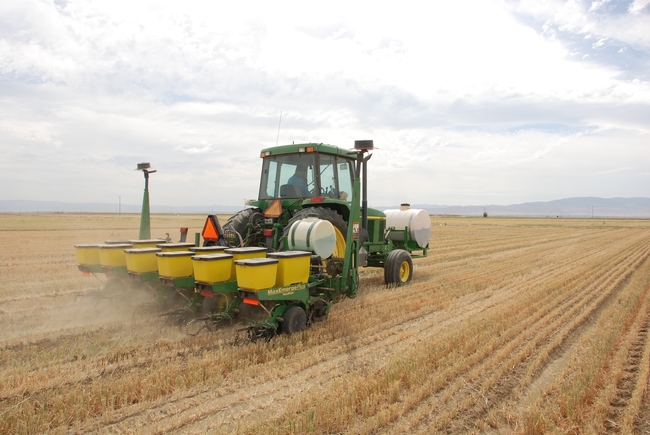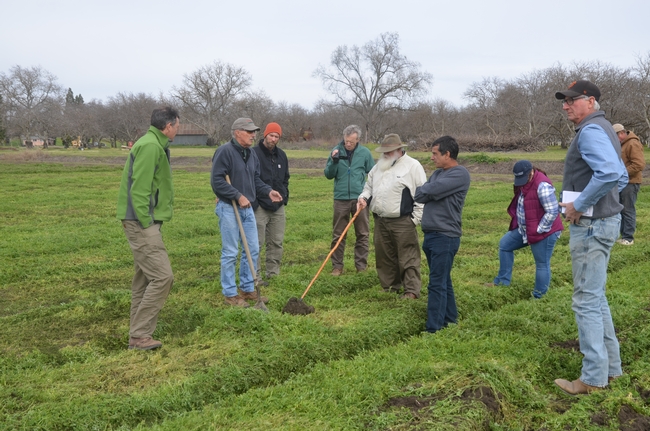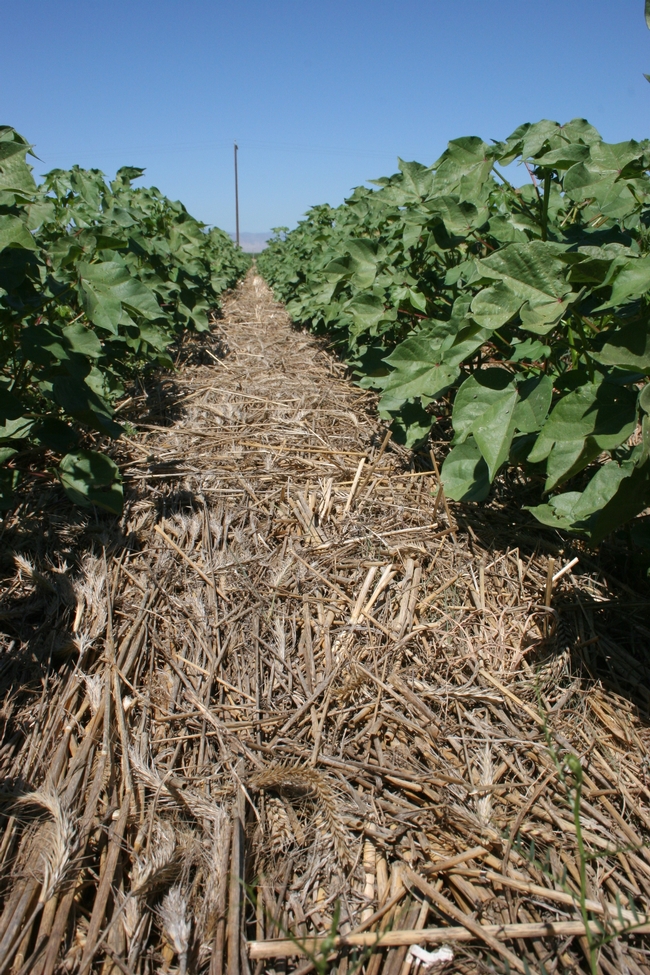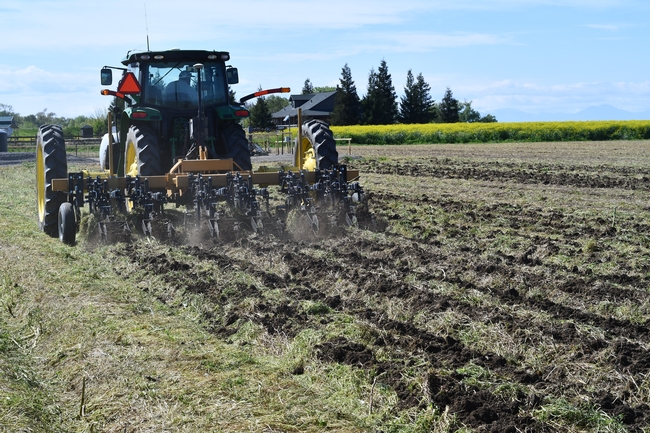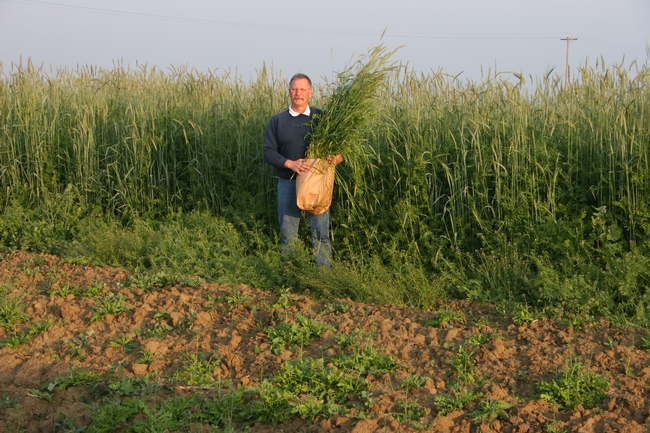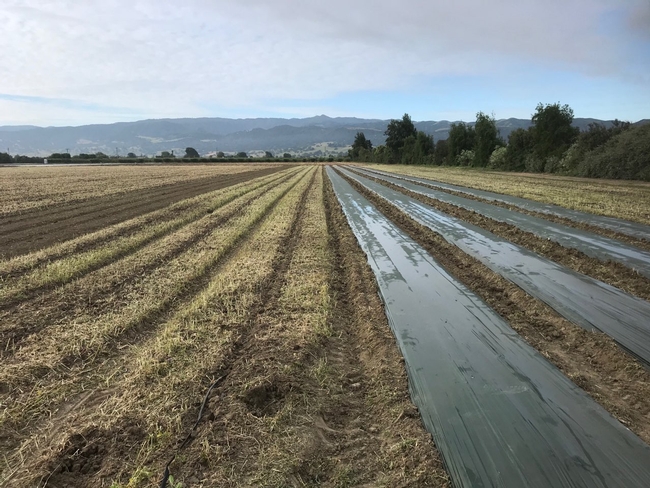- Author: Jeffrey P Mitchell
Information on the dynamics of long-term use of winter cover crops in California's San Joaquin Valley will be shared with online participants as part of the Desert Southwest Soil Health Webinar (https://www.eventbrite.com/e/desert-southwest-soil-health-webinar-tickets-107732693386), slated for July 23rd from 8 AM through 6 PM.
“This will be one of the first outlets in which we'll share our 20-year findings on both the costs and benefits of using cover crops to improve agroecosystem biodiversity and the efficiencies of the C, N, and water cycles in SJV annual cropping systems,” says UC ANR's Jeff Mitchell, whose presentation on conservation agriculture falls in the 10:30 AM – 3:00 PM “Practices to improve soil health,” slot on the day-long program.
Mitchell will describe how over the course of the project that was characterized by recurring drought, a total of 37 tons of aboveground cover crop biomass representing 1580 lbs N and 14.8 tons C per acre was produced with a total precipitation of 127 inches and 16 inches of supplemental irrigation in that was applied in four of the years. These inputs averaged 3,695 lbs of organic matter or 0.79 tons of C annually. Year-to-year variability was quite large ranging from 8,818 lbs OM in 2000 when supplemental irrigation was applied, to 54 lbs/ac in 2007 when, as in most years, no irrigation was applied to the cover crops. The cover crops were typically seeded by November 15 and terminated around March 15 of the following year accounting for a growth period of 120 days capturing solar energy by the “green ground cover”, and living roots in the soil for about 90 additional days during the year relative to the standard practice system which was bare during this time. Based on cover crop growth during years when supplemental irrigation was applied, Mitchell estimates that an average of 6,082 lbs of dry cover crop biomass might have been produced with a modest input of 2 inches of water. Even greater amounts of cover crop biomass – approximately 12,000 lbs of dry matter per acre as is typically achieved with winter silage triticale crops in SJV dairies - could be produced were cover crops “treated more like cash crops” with additional supplemental strategically timed irrigation in a cropping system as in other regions of the US. He'll also be showing participants via recorded video clips just how this sort of sustained cover crop use improves key soil health indicator properties and function.
CCA and PCA credit for the online webinar have been requested.
Photo caption
Image_0320
UC ANR Cropping Systems Extension Specialist, Jeff Mitchell, shown sampling winter cover crop aboveground biomass in longstanding conservation agriculture study of the impacts of reduced disturbance, cover crops, and surface residues on soil function, productivity, and ecosystem services at the Conservation Agriculture Systems study site in Five Points, CA
New data on cover crops to be presented July 23rd!
- Author: Jeffrey P Mitchell
Fifteen years of stunning conservation agriculture success at Rollin Valley Farms in Burrel, CA!
June 22, 2020
Andy Rollin, along with his brother, Donny, are dairy farmers near the small western San Joaquin Valley town of Burrel, CA. Their farm, Rollin Valley Farms, milks over 2,000 cows and has about 700 acres of silage crops including alfalfa, corn, oats, wheat, and sudangrass. About 15 years ago, they began some of the earliest efforts to develop reduced disturbance production techniques for their silage crops (see video below). They pioneered the successful development of strip-till corn way back in 2003 and 2004 and then a few years later, began working with Monte Bottens and Cary Crum of California Ag Solutions (CAS) in Madera, CA, to further improve their production systems. Monte and Cary helped them with state-of-the-art planter improvements, an Orthman 1-tRipR strip-till implement and also the use of CAS's Landoll no-till grain drill. (See Picture 1). In addition, the Rollins have in recent years added a late-summer multi-species silage “cover crop” which has now augmented their annual forage production over their prior double-cropping practices. Strip-till corn yields at their farm are up about 2 to 3 tons/acre over prior production rates and there have also been 10 to 15% improvements in their feed quality that have resulted from the coupled, innovative efforts that they have made.
The Rollins were also involved with a research study back in 2004 and 2005 with CASI's Nick Madden, Randy Southard, and Jeff Mitchell to determine the impacts of their reduced disturbance practices on air quality. (See Picture 2.)This work showed that over 85% of dust emissions were reduced by strip-till compared to their previous standard till system (see the attached article by Madden et al. 2008). (See Picture 3).
The Rollins are now firmly behind their transition to strip-till and no-till cover crops and small grain seeding schemes and attribute an early spring savings of about 10 days to their reduced disturbance corn planting systems. They now have switched to watering up their strip-till corn following the very minimal soil work they do following winter small grain chopping and harvesting. In recognition of their innovative and steadfast progress, they were Finalists in the 2018 Leopold Conservation Award Program. The following short video shows one of their strip-till corn fields this spring. (See Picture 4.)
Here is a link to a You Tube video of this project: https://youtu.be/mq8itVs3Iak
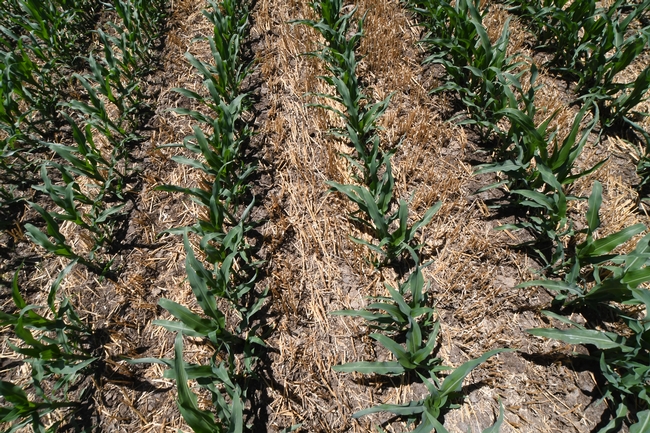

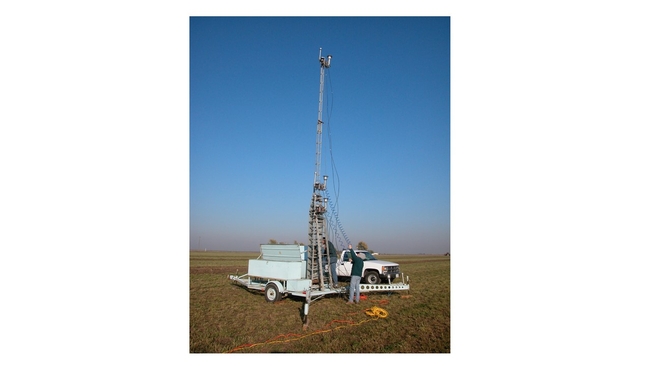
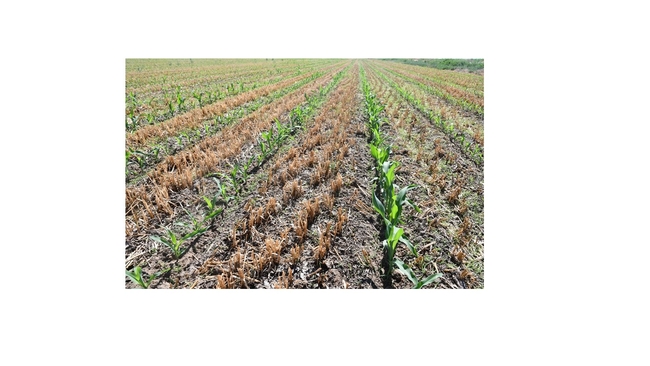
- Author: Jeffrey P Mitchell
May 20, 2020
Folks,
Here is a short 12-minute video update from Phil Foster on some of his recent reduced disturbance and shade cloth work with Tom Willey.
Keep going strong, everyone!
All the best,
Jeff
Phil Foster May 29, 2020 CASI Blog Post
- Author: Jeffrey P Mitchell
Soil health for the common good
April 18, 2020
Jeff Mitchell, Tom Willey and Paul Muller
Though humans thrived here for millennia without planting seeds or herding animals, the phenomenal success of California's short-lived agricultural experiment is staggering on a planetary scale,and represents barely over a century of building the highly productive food systems that benefit us all today. The farmers who manage the fields, orchards, and vineyards of our Golden State contribute greatly to the common good by providing abundant food from an astonishing variety of crops. Yet,present and looming challenges of water supply, climate change, air quality and the long-term fertility and sustainability of California's agricultural soils threaten continued productivity. Such challenges compel farmers, researchers, and the private sector to pursue creative soil management innovations that harmonize with the biological foundations of resource use efficiency, if California agriculture's future productivity is to be safeguarded.
This soil health initiative which is based on principles including deliberater eduction of soil disturbance, generating and preserving surface residues from a broadened diversity of plant species that are grown to enhance active soil biology and capture maximum solar energy over time, is undoubtedly having clear impact in many regions of the country. Within California, over the past four years, NRCS has provided some $5.4M in cost-share payments for soil health-related conservation practices to 172 applicants.California Department of Food and Agriculture's (CDFA) Healthy Soils Program,launched in 2017, is designed to generate similar impacts and benefits (https://www.cdfa.ca.gov/oefi /healthysoils/Indeed, CDFA has invested over $50M and to support 307 projects that incentivize adoption of these core soil health management practices.These two government programs are complementary, with NRCS incentivizing voluntary adoption and CDFA supporting a broader range of on-farm research costs and activities beyond simple practice implementation.
Observing our State's annual cropland – the many bare, open fields we drive by when we're out in the country – the fact of the matter is that woefully few examples of the successful integration of these basic soil health principles are apparent across California's immense farmscape. By and large, the very same tillage-intensive, high-disturbance soil management practices that have been employed for 90 years in most crop fields are still being used today
“When is the last time that you actually saw a no-till, high-residue field anywhere in CA?” asks Jeff Mitchell of UC's Conservation Agriculture Systems Innovation Center.“Whenever we host out-of-state folks who've themselves pioneered soil health practice implementation back home, they are astonished by the outright sheer intensity of tillage disturbance and lack of protective residue cover in our State's annual crop fields.”
Government programs approach things in a piecemeal way. The full complement of integrated soil health principles are not being implemented in very many of either USDA's or CDFA's programs. Where cover crops are encouraged, they end up typically being plowed back into the soil by full-on disruptive tillage. That costs money and it flies in the face of the avowed comprehensive systems goals for soil health management that these agencies endorse.Piecemeal government incentives might contribute to a very gradual forward movement of California's food production systems, but they represent incremental, “practice substitution” progress at best. These efforts lack a broader systems rationale for change.
A far more ambitious effort though, is now underway that goes well beyond these fragmented government initiatives. It involves a small group of organic farmers who themselves realize that core soil health, or conservation agriculture principles can make not only ecological, but also economic sense. These folks are looking far beyond cashing in on government rewards. They understand that evolving a natural systems agriculture has been their modern organic movement's holy grail since its 20th century inception.On all fronts, this group realizes whatas Pennsylvania no-till and cover crop farmer, Steve Groff points out, “You'll become obsolete if you're not future-proofing your farm ahead of not only environmental imperatives, but also market and consumer demands.”
This California farmer group might be leading a revolution - but as David Montgomery, author of Growing a revolution – Bringing Our Soil Back to Life, says - it is a movement that “is growing bottom-up, fueled by individual farmers rather than governments, universities or environmental advocacy groups.” Their innovation, which involves year-round soil cover, greatly reduced disturbance tillage, and integration of grazing animals into crop fields aims to enhance the health of their soils, the health of their farms and the quality of the food they produce. Data compiled from project's early stages demonstrates that sustained long-term 'natural systems mimicry' these farmers have used over decades resulted in improvements in a number of key soil health properties including carbon storage, water holding capacity, and crop nutrient availability.
An underlying challenge that these farmers face, as does all of agriculture, was addressed by Guinda organic vegetable farmer and member of the project,Paul Muller, “We are at a point where many people are asking how our farming systems can do more for the common good. Long-term stewardship and soil health is a common good; careful water stewardship enhances the common good; finding economic strategies to support and nurture those who grow our food and steward our resources for the long-term is a common good; capturing more carbon with cover crops and reduced tillage to feed a teeming microbial universe underfoot is a common good.Clothing naked soil and minimizing dangerous pesticides in our food system is a common good; growing nutrient-dense food is a common good. It is all related, and companies can invest in an equitable supply chain where these common good values are properly rewarded. The question remains: ‘Who pays for the defense and enhancement of the common good?'"
This is not going to be an easy question to answer. Three members of the group recently met with representatives of fifteen major US restaurant chains to begin a dialog aimed at exploring what will be needed to reform our current food system in ways that promote soil, farm, and human health, all while enabling farmers to continue to innovate and develop the alternative systems that we will all need. Project farmer Tom Willey may have surprised the listeners with his summation: “We find ourselves in the current predicament because we get what we pay for. Good food isn't cheap, and cheap food isn't good.”
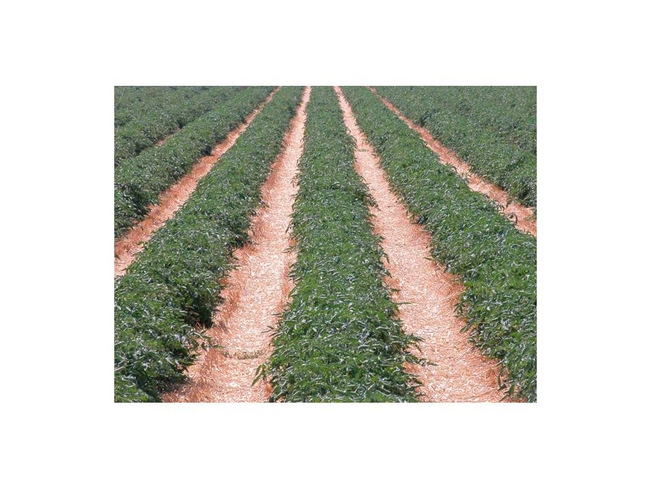
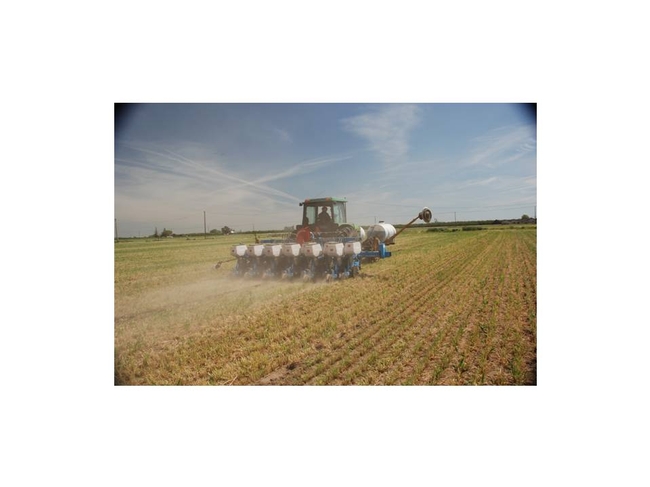
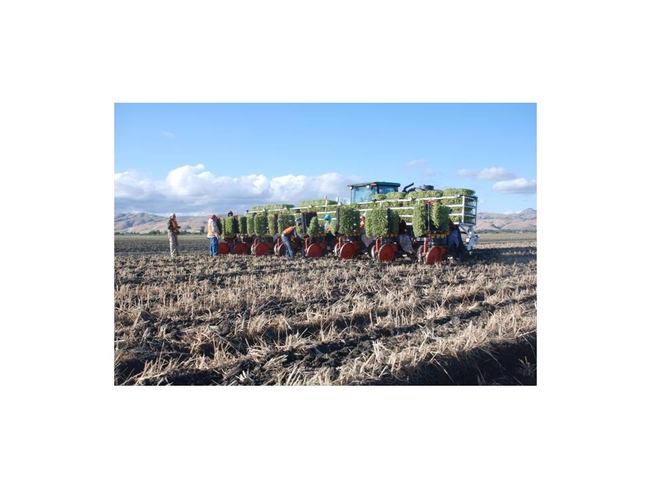
- Author: Jeffrey P Mitchell
- Author: Anil Shrestha
- Author: Jeannette E. Warnert
This is a preview of an article for Progressive Crop Consultant magazine.
Recently, two types of evidence have emerged to indicate that farmers must make substantial changes in their crop production systems in the future. The first is economic. If farmers want to preserve their markets, they must use farming practices in alignment with buyer preferences. This concept appears front-and-center in the You Tube video, “How to future-proof your farm (and not become obsolete!),” by Pennsylvania farmer Steve Groff.
“Is your farm becoming obsolete?” Groff asks. “There are changes coming over the horizon in our industry that have ripple effects and are forcing farmers to make difficult decisions about how they manage their soil. The reality is that you will come face-to-face with the supply chain that you are a part of.”
As Groff points out, if you don't improve the way you're doing things, your markets will disappear.
This economic point was further driven home in the opening keynote address by Nestle vice president Patricia Stroup at last fall's Sustainable Agriculture Summit in Indianapolis. Stroup spoke to over 650 of the world's major food brand and market representatives. “If you want to sell your food to us, you'll meet our specifications,” was her stern admonition.
Nestle, by the way, is the world's largest food company – buying and selling food in every country on the globe.
Now, just what are these “specifications” for how crops are produced? Where do they come from and what are they based on? The answer is simple. It's all about HEALTH – soil health, farm health, and human health. Strengthening connections between these three dimensions of planetary health is now gaining momentum in the public, markets that farmers rely upon, but also increasingly by medical health experts. There is now a growing recognition that human health is intimately connected to the nutritional quality of the food we eat, which in turn is connected to the health of farms that produce the food, and ultimately to the health of the soil in which crops grow. These converging values lead to the recognition among a growing sector of society that ‘food is medicine' and that nutrient-dense, pesticide-free food comes from healthy farms with biologically active soils.
There are now several visionary physicians and healthcare administrators on the front lines of this emerging arena calling for us to build bridges between human health, farm health and soil health. ALL IN Alameda!, a collaborative initiative led by Alameda family physician Dr. Steven Chen, MD, is a shining example of integrative medicine. Recognizing the value of high-quality food, county clinics in Alameda are partnering with local organic urban farmers and writing vegetable prescriptions for patients. They are making remarkable positive impacts on a number of health indicators,including diabetes and hypertension, conditions that frequently afflict the largely low-income population in urban “food deserts.” Dr. Chen is fond of quoting writer and environmental activist Wendell Berry: “People are fed by the food industry, which pays no attention to health, and are treated by the health industry, which pays no attention to food.” Dr. Chen adds, “and both the food and health industries pay no attention to the agricultural industry.”
The evidence that supports new food and crop production paradigms is growing stronger. Markets are leaning toward supporting farmers who use practices that contribute to a healthier food system and ultimately, healthier people, and, in turn, lower-cost healthcare. Focusing on an “agricultural revolution” will compensate farmers for cultivating the land and delivering “public goods” in terms of climate change mitigation, ecosystem conservation and public health outcomes. Governments, including Great Britain, are moving to scale up incentives to farmers employing such practices.
Ecological evidence
There is also strong ecological evidence in support of a farming revolution. Overall soil health is directly affected by reducing disturbance, keeping the surface covered and encouraging biodiversity both above and below ground (Photo 1). Research shows that farmers who use ‘natural systems' gain a host of important benefits, including the ability to use less fertilizer and water, capture and store more carbon, and require fewer inputs overall. Our research in California's San Joaquin Valley, for instance, has demonstrated that the combination of no-tillage (reduced disturbance) with cover crops reduces water applied over the course of the season by 13%, the equivalent of about 4 to 5 inches. In addition, no-till cuts dust emissions from the field by over 75%,and combining no-till with cover crops leads to increases in soil carbon, water infiltration, soil aggregation, water holding capacity and biological diversity. The ecological evidence from many other sources around the world support these soil care, conservation agriculture practices.
The early-generation pioneers who have become successful using these techniques tend to be organic farmers who seek to emulate natural systems. A group of California farmers who have been leaders in soil care, worker health and farm health are now working together through an NRCS Conservation Innovation Grant (CIG) project to develop crop production system alternatives for vegetable crops. (Photo 2). More information about this group is available at our Conservation Agriculture Systems Innovation (CASI) website and by joining our project's Collaborative Tools network http://casi.ucanr.edu/? Blogpost =40712&blogasset=14128.
It's now time to work together to scale-up improved farming systems across the board. We should no longer view food as just a substance to be bought and sold as cheaply as possible, but rather food as medicine. Paul Muller, a Guinda organic farmer and member of the CIG project, puts it this way: “We are at a point where many people are asking how our farming systems can do more for the common good. Long-term soil stewardship and health soil is a common good; thinking through water stewardship in healthy soils enhances the common good; finding strategies to support and nurture those who grow our food and tend or steward our resources for the long-term is a common good; putting more carbon through cover crops and reduced tillage of the soil and keeping carbon as a food for a teeming microbial universe there is a common good; keeping that soil covered, minimizing dangerous pesticides in the food system is a common good; growing more nutrient-dense food is a common good. It is all related and companies can invest in this supply chain and support its growth and create a supply chain of value where all parts are rewarded for doing something good for consumers. The question is, ‘Who pays for the defense and enhancement of the common good?'"
This is not going to be an easy question to answer. Fortunately,innovators are beginning to put the pieces together. (Photo 3). One such effort involves the National Cotton Council, the U.S. Cotton Trust Protocol, Cotton Incorporated, and cotton farmers, such as John Teixeira of Firebaugh, who has many years of experience with soil health management systems. The organizations are working with companies like Wranglers, Levi-Strauss, and Walmart, and researchers with experience in both the soil and human health domains. Read more about this effort here: http://casi.ucanr.edu/?blogpost=39614&blogasset=14128.
Federal and state government agencies are also involved in similar soil health initiatives. In 2012, the USDA's Natural Resource Conservation Service launched “Unlock the secrets of the soil,” a major national education and awareness campaign about the core principles of conservation agriculture and soil health. This initiative will have a broad impact in many regions of the country. The California Department of Food and Agriculture's Healthy Soils Program, started in 2017, is now also having similar impacts and benefits (https://wwwcdfa.ca.gov/oefi/healthsoils/). Indeed, CDFA has invested over $50 million and supported 307 projects incentivizing adoption of core soil health management practices.
However, it is ultimately the pioneering, visionary farmers who are leading the movement (Photo 4). As renowned author David Montgomery puts it in “Growing a Revolution – Bringing our soil back to life,”“the movement is growing bottom-up, fueled by individual farmers rather than governments, universities, or environmental advocacy groups.” The excitement and the future of our food system is now in the hands of farmers who see a better way forward and are working hard to get there.
There are now clear roles that professional crop consultants can play. Imagine contributing creatively to the development of a completely new paradigm for farming systems that emphasize soil, farm and human health. Imagine becoming part of the effort to push far beyond IPM strategies that have been developed over the past 50 years and creating systems that are pesticide-free. The economic and ecological evidence suggests that we have a commanding mandate to do so.
Jeff Mitchell is a Cooperative Extension Cropping Systems Specialist in the Department of Plant Sciences at the University of California, Davis. Anil Shrestha is Professor and Department Chair of the Department of Viticulture and Enology at California State University, Fresno. Jeannette Warnert is Communications Specialist with the University of California Division of Agriculture and Natural Resources.
